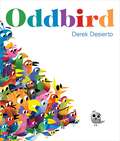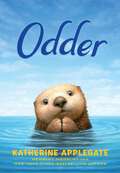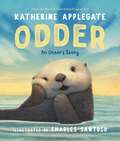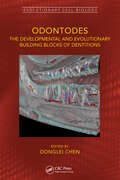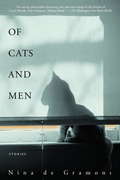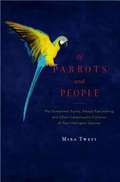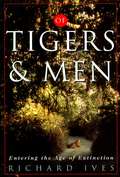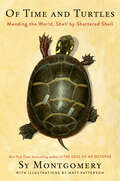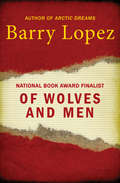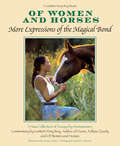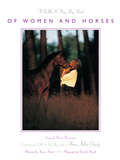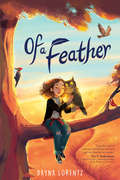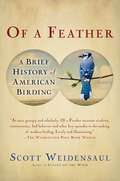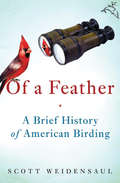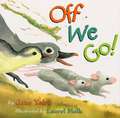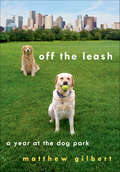- Table View
- List View
Oddbird
by Derek DesiertoA picture book from Derek Desierto about a bird who doesn’t fit in…at first! It’s SO hot outside. All the fancy birds are gathered around the water, wishing they could cool off. But they don’t want to get wet and ruin their fine feathers.Oddbird isn’t worried about his feathers; he wants to go for a refreshing dip. But he doesn’t fit in. He’s not fancy, or colorful. He’s just…different. The other birds don't want him around. How can he join them?Oddbird's story is one all readers will relate to, and ultimately celebrate.
Odder
by Katherine ApplegateA touching and lyrical tale about a remarkable sea otter, from Newbery Medalist Katherine Applegate, author of Wishtree.Meet Odder, the Queen of Play: Nobody has her moves.She doesn’t just swim to the bottom,she dive-bombs.She doesn’t just somersault,she triple-doughnuts.She doesn’t just ride the waves,she makes them.Odder spends her days off the coast of central California, practicing her underwater acrobatics and spinning the quirky stories for which she’s known. She’s a fearless daredevil, curious to a fault. But when Odder comes face-to-face with a hungry great white shark, her life takes a dramatic turn, one that will challenge everything she believes about herself—and about the humans who hope to save her.Inspired by the true story of a Monterey Bay Aquarium program that pairs orphaned otter pups with surrogate mothers, this poignant and humorous tale told in free verse examines bravery and healing through the eyes of one of nature’s most beloved and charming animals.
Odder: An Otter's Story (Picture Book)
by Katherine ApplegateA stunning picture book from acclaimed author Katherine Applegate, adapted from the #1 bestselling middle-grade novel that spent 100 weeks on the New York Times bestseller list!Odder spends her days playing underwater and learning life lessons from her mother. But when Odder’s life takes a dramatic turn, she is rescued by humans. The people are kind, and introduce Odder to other rescues. Soon, it’s clear that Odder has a talent for teaching other pups how to otter. Adapted from Katherine Applegate’s bestselling novel of the same name (with over 80 weeks on the New York Times Bestseller list!), and inspired by the true story of a program that pairs orphaned otter pups.
Odie Unleashed!: Garfield Lets the Dog Out (Garfield)
by Jim DavisThe Dog Finally Has His Day! After years of living in Garfield&’s supersized shadow, Odie breaks loose with a book of his own. Sure, the fat cat&’s slobbering sidekick may be a few dog biscuits shy of a box, but he&’s all heart—or is that all tongue? Odie&’s fetched his favorite strips and quips for this comical canine collection, so enjoy! Just watch out for dog breath! <P><P><i>Advisory: Bookshare has learned that this book offers only partial accessibility. We have kept it in the collection because it is useful for some of our members. Benetech is actively working on projects to improve accessibility issues such as these.</i>
Odontodes: The Developmental and Evolutionary Building Blocks of Dentitions (Evolutionary Cell Biology)
by Donglei ChenThe odontode system, which encompasses teeth and other dentine-based structures, is ancient. Odontodes are present in the oldest vertebrate fossils, dating back 500 million years, and still play an important role in the anatomy and function of living jawed vertebrates. Fossils preserve odontode tissues with remarkable nanoscale fidelity, allowing the evolution and diversification of the odontode system to be studied in deep time as well as across the diversity of living vertebrates. This synthetic volume presents an overview of odontode research by internationally leading researchers from different fields of biology.. Key Features Summarizes classic and cutting-edge research devoted to the development and evolution Focuses on the cellular aspects of odontogenesis Documents the structural and functional diversity of odontode tissues Describes the patterning mechanisms of dentitions in various vertebrate groups Provides a thorough index for students
Of Cats and Men: Profiles of History's Great Cat-Loving Artists, Writers, Thinkers, and Statesmen
by Sam KaldaA stylish, illustrated gift book profiling notable cat-loving men throughout history. Some of history’s greatest men have been cat lovers, and their cats have contributed to their genius and legacy: the static charge from a cat’s fur sparked young Nikola Tesla’s interest in electricity; Sir Isaac Newton is said to have invited the first cat flap; visitors to Ernest Hemingway and Winston Churchill’s homes still encounter the descendants of their beloved cats; William S. Burroughs and Andy Warhol both wrote books inspired by their feline friends.Stylishly illustrated and full of charming, witty profiles and quotes from history’s most notable “cat men,” Of Cats and Men pays tribute to thirty luminaries and visionaries who have one thing in common: a pure and enduring love of cats.
Of Cats and Men: Stories
by Nina De GramontHaughty Bengals, Himalayan high points and feral strays: these are the haunting familiars of Nina de Gramont's superbly imagined collection of themed tales. Prowling through every story, these enigmatic creatures expose the hidden fears and passions of the female heart, and illuminate the deep truths about men and love. A young woman finds two dark surprises in her home: a magpie dismembered by her two cats, and an unsettling glimpse of her fiance's secret inclinations. A frustrated newlywed clings to the pampered pet which is the last vestige of her privileged upbringing, until a rangy stray shows her the true meaning of marriage. As clever and finessed as the feline disposition it celebrates, OF CATS AND MEN marks the arrival of an exciting new voice in fiction.
Of Flame and Fury
by Mikayla BridgeFourth Wing meets Iron Widow in this enemies-to-lovers romantic fantasy by debut author Mikayla Bridge. The hottest must-read of the summer!On an island built from ash and shrouded in fire, phoenix racing is a sport just as profitable as it is deadly.Kel Varra and her team of underdogs, the Crimson Howlers, are desperate to win the annual races and the fortune that comes with it. But the Howlers need a new rider, which leads Kel to join forces with Warren “Coup” Coupers – an arrogant rival she can’t get out of her head.As tensions rise on and off the track, Kel accepts a job from a mysterious tech mogul who shows an unsettling interest in her phoenix, Savita. This thrusts Kel into a conspiracy that endangers everyone she cares about, especially Coup, as her resentment ignites into something dangerously new.Heart-pounding pages full of fiery romance, jaw-dropping confessions, political scheming, and volatile magic culminate in a final battle that none may survive.
Of Mutts and Men (A Chet & Bernie Mystery #10)
by Spencer QuinnSpencer Quinn's Of Mutts and Men is the latest in the New York Times and USA Today bestselling series that the Los Angeles Times called “nothing short of masterful"…When Chet the dog, “the most lovable narrator in all of crime fiction” (Boston Globe), and his partner, PI Bernie Little of the desert-based Little Detective Agency, arrive to a meeting with hydrologist Wendell Nero, they are in for a shocking sight—Wendell has come to a violent and mysterious end. What did the hydrologist want to see them about? Is his death a random robbery, or something more? Chet and Bernie, working for nothing more than an eight-pack of Slim Jims, are on the case. Bernie might be the only one who thinks the police have arrested the wrong man, including the perp’s own defense attorney. Chet and Bernie begin to look into Wendell’s work, a search that leads to a struggling winemaker who has received an offer he can’t refuse. Meanwhile, Chet is smelling water where there is no water, and soon Chet and Bernie are in danger like never before.At the Publisher's request, this title is being sold without Digital Rights Management Software (DRM) applied.
Of Orcas and Men: What Killer Whales Can Teach Us
by David NeiwertA journalist &“convincingly spells out the threats to their survival, their misery in captivity, and what scientists can learn by studying them&” (Kirkus). The orca—otherwise known as the killer whale—is one of earth&’s most intelligent animals. Remarkably sophisticated, orcas have languages and cultures and even long-term memories, and their capacity for echolocation is nothing short of a sixth sense. They are also benign and gentle, which makes the story of the captive-orca industry—and the endangerment of their population in Puget Sound—that much more damning. In Of Orcas and Men, a marvelously compelling mix of cultural history, environmental reporting, and scientific research, David Neiwert explores an extraordinary species and its occasionally fraught relationship with human beings. Beginning with their role in myth and contemporary culture, Neiwert shows how killer whales came to capture our imaginations, and brings to life the often catastrophic environmental consequences of that appeal. In the tradition of Barry Lopez&’s classic Of Wolves and Men, David Neiwert&’s book is a triumph of reporting, observation, and research, and a powerful tribute to one of the animal kingdom&’s most remarkable members.Praise for Of Orcas and Men &“Human beings need to learn from and understand the cooperative nature of orca society. Everyone who is interested in both animal and human behavior should read this remarkable book.&” —Temple Grandin, New York Times–bestselling author of Animals in Translation and Animals Make Us Human &“Powerful and beautifully written.&” —Jane Goodall &“Humans and killer whales have a long and complicated history, one that David Neiwert describes forcefully and eloquently in this fascinating and highly readable book.&” —David Kirby, New York Times–bestselling author of Death at SeaWorld &“[A] breathtaking survey of orca science, folklore, and mystery.&” —The Stranger
Of Parrots and People
by Mira TwetiThere are an estimated 50 million parrots in the United States today. Their intelligence and extraordinary personalities make them beloved members of the families that bring them into their homes. In Of Parrots and People, award-winning journalist and long-time parrot owner Mira Tweti reveals the complex world of parrots-their astonishing intellect, often-intimate relationships with humans, and, unfortunately, the calamitous practices of the bird industry. Delving into the secret world of the global parrot trade, Tweti documents the forces driving these remarkable creatures to the brink of extinction. A critical addition to the popular shelf of books about animals and their behavior, Of Parrots and People is a startling wake-up call in the tradition of Rachel Carson's Silent Spring. .
Of Poseidon
by Anna BanksGalen, a Syrena prince, searches land for a girl he's heard can communicate with fish. It's while Emma is on vacation at the beach that she meets Galen. Although their connection is immediate and powerful, Galen's not fully convinced that Emma's the one he's been looking for. That is, until a deadly encounter with a shark proves that Emma and her Gift may be the only thing that can save his kingdom. He needs her help--no matter what the risk. Of Poseidon is the start of The Syrena Legacy series by Anna Banks.
Of Tigers and Men
by Richard IvesChronicles the author's four-year search for the wild tiger that followed his discovery that tigers were being driven toward extinction, and describes the world he saw and his desire to meet a tiger unarmed and face-to-face.
Of Time and Turtles: Mending the World, Shell by Shattered Shell
by Sy MontgomeryNational Book Award finalist for The Soul of an Octopus and New York Times bestseller Sy Montgomery turns her journalistic curiosity to the wonder and wisdom of our long-lived cohabitants—turtles—and through their stories of hope and rescue, reveals to us astonishing new perspectives on time and healing.When acclaimed naturalist Sy Montgomery and wildlife artist Matt Patterson arrive at Turtle Rescue League, they are greeted by hundreds of turtles recovering from injury and illness. Endangered by cars and highways, pollution and poachers, these turtles—with wounds so severe that even veterinarians would have dismissed them as fatal—are given a second chance at life. The League’s founders, Natasha and Alexxia, live by one motto: Never give up on a turtle.But why turtles? What is it about them that inspires such devotion? Ancient and unhurried, long-lived and majestic, their lineage stretches back to the time of the dinosaurs. Some live to two hundred years, or longer. Others spend months buried under cold winter water. Montgomery turns to these little understood yet endlessly surprising creatures to probe the eternal question: How can we make peace with our time?In pursuit of the answer, Sy and Matt immerse themselves in the delicate work of protecting turtle nests, incubating eggs, rescuing sea turtles, and releasing hatchlings to their homes in the wild. We follow the snapping turtle Fire Chief on his astonishing journey as he battles against injuries incurred by a truck.Hopeful and optimistic, Of Time and Turtles is an antidote to the instability of our frenzied world. Elegantly blending science, memoir, philosophy, and drawing on cultures from across the globe, this compassionate portrait of injured turtles and their determined rescuers invites us all to slow down and slip into turtle time.Perfect gift for nature lovers.Includes a signature of photos plus stunning, photo-realistic full color paintings and black-and-white chapter opener art by wildlife artist Matt Patterson.Read more books by Sy Montgomery such as How to Be a Good Creature and The Soul of an Octopus.Don't miss The Book of Turtles for children.
Of Wolves and Men
by Barry Holstun LopezThe wolf and its relations with humans in myth and in reality.
Of Wolves and Men
by Barry LopezNational Book Award Finalist: A &“brilliant&” study of the science and mythology of the wolf by the New York Times–bestselling author of Arctic Dreams (The Washington Post). When John Fowles reviewed Of Wolves and Men, he called it &“A remarkable book, both biologically absorbing and humanly rich, and one that should be read by every concerned American.&” In this National Book Award–shortlisted work, literary master Barry Lopez guides us through the world of the wolf and our often-mistaken perceptions of another species&’ place on our shared planet. Throughout the centuries, the wolf has been a figure of fascination and mystery, and a major motif in literature and myth. Inspiring fear and respect, the creature has long exerted a powerful influence on the human imagination. Of Wolves and Men takes the reader into the world of the Canis lupus and its relationship to humankind through the ages. Lopez draws on science, history, mythology, and his own field research to present a compelling portrait of wolves both real and imagined, dispelling our fear of them while celebrating their place in our history, legends, and hearts. This ebook features an illustrated biography of Barry Lopez including rare images and never-before-seen documents from the author&’s personal collection.
Of Wolves and Men
by Barry LopezOriginally published in 1978, this classic exploration of humanity&’s complex relationship with and understanding of wolves returns with a new afterword by the author.Humankind's relationship with the wolf is the sum of a spectrum of responses ranging from fear to admiration and affection. Lopez&’s classic, careful study has won praise from a wide range of reviewers and improved the way books on wild animals are written. Of Wolves and Men explores the uneasy interaction between wolves and civilization over the centuries, and the wolf's prominence in our thoughts about wild creatures. Drawing upon an impressive array of literature, history, science, and mythology as well as extensive personal experience with captive and free-ranging wolves, Lopez argues for the wolf's preservation and immerses the reader in its sensory world, creating a compelling portrait of the wolf both as a real animal and as imagined by different kinds of men. A scientist might perceive the wolf as defined by research data, while an Eskimo hunter sees a family provider much like himself. For many Native Americans the wolf is also a spiritual symbol, a respected animal that can strengthen the individual and the community. With irresistible charm and elegance, Of Wolves and Men celebrates careful scientific fieldwork, dispels folklore that has enabled the Western mind to demonize wolves, explains myths, and honors indigenous traditions, allowing us to understand how this remarkable animal has become so prominent for so long in the human heart.
Of Women And Horses: Vol 2
by Gawani Pony Boy Mark J. BarrettIn the tradition of "Horse Follow Closely", GaWaNi Pony Boy gathers an impressive array of known and unknown horsewomen, who, in touching prose, describe the unique relationships they have with their horses.<P> GaWaNi Pony Boy's unique approach to horses is captured in these five books from BowTie Press. GaWaNi Pony Boy is the founder and president of lyuptala University (lyuptala means "one-with" in Lakota), and online college that allows horse lovers to expand their knowledge of these magnificent animals. He regularly writes for equine publications throughout the United States and Europe.
Of Women and Horses: Essays by Various Horse Women
by Gawani Pony Boy Gabrielle BoiselleA survey of horsewomen introduces women from all walks of life as they explore their love of horses.<P> GaWaNi Pony Boy's unique approach to horses is captured in these five books from BowTie Press. GaWaNi Pony Boy is the founder and president of lyuptala University (lyuptala means "one-with" in Lakota), and online college that allows horse lovers to expand their knowledge of these magnificent animals. He regularly writes for equine publications throughout the United States and Europe.
Of a Feather
by Dayna Lorentz"A perfect tale of outcasts, friendship, falconry, and the families we create.&”--Tui T. Sutherland, New York Times bestselling author of the Wings of Fire seriesIn the vein of Barbara O&’Connor&’s Wish, a moving, poignant story told in alternating perspectives about a down-on-her-luck girl who rescues a baby owl, and how the two set each other free. Great horned owl Rufus is eight months old and still can&’t hunt. When his mother is hit by a car, he discovers just how dangerous the forest can be. Reenie has given up on adults and learned how to care for herself—a good thing, since she&’s sent to live with an aunt she&’s never met. Yet this aunt has a wonderful secret: she&’s a falconer who agrees to help Reenie catch an injured passage hawk in the wild and rehabilitate it. When Reenie traps bedraggled Rufus, his eyes lock onto her heart, and they form a powerful friendship. But can Rufus learn to trust in the outside world and fly free? And can Reenie open her heart enough to truly soar?
Of a Feather: A Brief History of American Birding
by Scott WeidensaulEuropeans were awestruck by a continent awash with birds. Today tens of millions of Americans birders have made a once eccentric hobby into something so mainstream its (almost) cool. Scott Weidensaul traces the colorful evolution of American birding.
Of a Feather: A Brief History of American Birding
by Scott WeidensaulBeyond Audubon: A quirky, &“lively and illuminating&” account of bird-watching&’s history, including &“rivalries, controversies, [and] bad behavior&” (The Washington Post Book World). From the moment Europeans arrived in North America, they were awestruck by a continent awash with birds—great flocks of wild pigeons, prairies teeming with grouse, woodlands alive with brilliantly colored songbirds. Of a Feather traces the colorful origins of American birding: the frontier ornithologists who collected eggs between border skirmishes; the society matrons who organized the first effective conservation movement; and the luminaries with checkered pasts, such as Alexander Wilson (a convicted blackmailer) and the endlessly self-mythologizing John James Audubon. Naturalist Scott Weidensaul also recounts the explosive growth of modern birding that began when an awkward schoolteacher named Roger Tory Peterson published A Field Guide to the Birds in 1934. Today, birding counts iPod-wearing teens and obsessive &“listers&” among its tens of millions of participants, making what was once an eccentric hobby into something so completely mainstream it&’s now (almost) cool. This compulsively readable popular history will surely find a roost on every birder&’s shelf. &“Weidensaul is a charming guide. . . . You don&’t have to be a birder to enjoy this look at one of today&’s fastest-growing (and increasingly competitive) hobbies.&” —The Arizona Republic
Off We Go
by Jane YolenJoin Little Mouse, Little Frog, Little Mole, Little Snake, and other baby critters as they creep, scritch, and slither their way to their respective Grandmas' houses.
Off the Leash: A Year at the Dog Park
by Matthew GilbertA heartwarming story about a man and his dog, and the first-ever book about dog parks and the part they play in the lives of both humans and canines.Off the Leash is a group portrait of dog people, specifically the strange, wonderful, neurotic, and eccentric dog people who gather at AmoryPark, overlooking Boston near Fenway Park. It’s about author Matthew Gilbert’s transformation into one of those dog people with fur on their jackets, squeaky toys in their hands, and biscuits in their pockets.Gilbert, longtime TV critic at The Boston Globe, describes his reluctant trip into the dog-park subculture, as the first-time owner of a stubbornly social yellow Lab puppy named Toby. Like many Americans, he was tethered to the digital leash. But the headstrong, play-obsessed Toby pulls him to Amory, and Amory becomes an exhilarating does of presence for him. At the dog park, the dog owners go off the leash, too.Dog-park life can be tense. When dogs fight, their owners bare their teeth at each other, too. Amid the rollicking dog play, feelings tend to surface faster, inedited. Amory becomes, for the dog owners, an idyllic microcosm, the home of enduring friendships and romantic crushes. Meeting daily, a gathering of dog owners can be like group therapy.A charming narrative, Off the Leash will appeal to anyone who has ever enjoyed watching a puppy scamper through a park.Praise for Off the Leash“An admitted curmudgeon just a few steps away from Cruella de Vil, Gilbert sees his life change when he falls in love with a dog person and then falls in love with dogs. . . . Gilbert captures with great humor the world within the dog park. . . . Beyond the individual quirks, Gilbert finds community and the ability to empathize among people who on the surface have little in common.” —Los Angeles Times“Gilbert’s book is witty, sweet, and affirming.” —The Boston Globe
